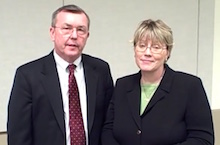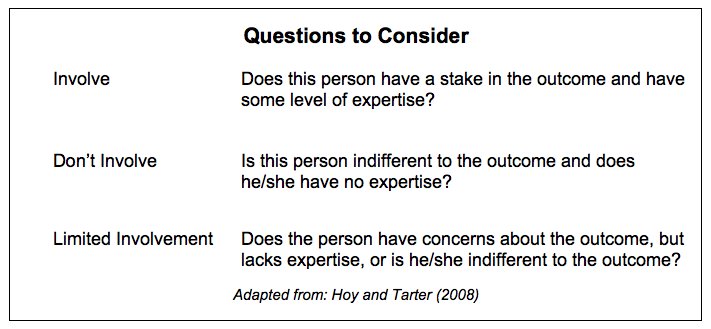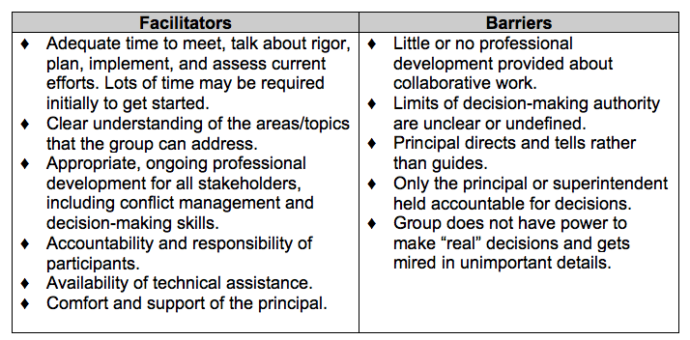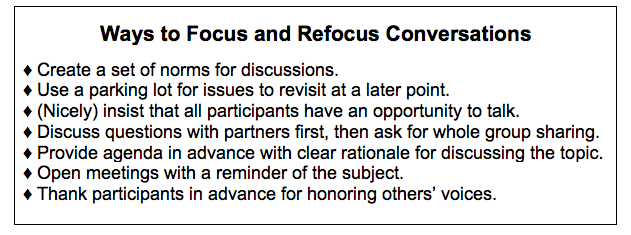How Leaders Develop Stakeholder Ownership
 By Ronald Williamson and Barbara Blackburn
By Ronald Williamson and Barbara Blackburn
Efforts to improve your school will only be successful with widespread support and ownership. When a principal or central office mandates an initiative, it almost guarantees resistance and inadequate implementation.
Involving all stakeholders, families, and community, as well as teachers and other staff, is essential. Participation and involvement are central to building collective commitment to improving your school. There are three keys to developing ownership from stakeholders.
► Find authentic opportunities for participation and shared decision-making.
► Determine who to involve in different activities.
► Build effective two-way communication.
Finding Authentic Opportunities
There is no perfect way to involve stakeholders in the discussion about school improvement. What’s most critical is that their participation must be authentic. Involvement can’t be trivialized or used to mask the decisions of administrators. The tasks must be real and their involvement valued. There are things that support involvement as well as the things that may be an obstacle.
Before determining who to involve in aspects of decision-making, it’s important to think about the facilitators and barriers to involvement. At a basic level, a willingness to participate is a great facilitator or motivator. Similarly, not wanting to be involved will serve as a barrier. For some of your stakeholders, the barrier may be circumstance-dependent.
For example, a faculty member with a new child may not have the time or energy to take a leadership role at the current time. However, the same teacher may be more than willing to train new faculty the following year. We worked with one school where one teacher wanted to chair the planning committee. He was the ideal choice, but because he was also developing a new curriculum and pacing guide for the district, he asked to serve on the committee without chairing it.
From a broader perspective, there are a variety of facilitators and barriers to involvement for you to consider prior to asking individuals to participate.
Determine Whom to Involve
Deciding whom to involve in a project is critical. If people have a stake in the outcome of the decision, they should be represented. Be sure to involve those who have needed expertise. If a person or group is indifferent or has no expertise, their involvement might be very limited.
However, it is important to engage everyone in the conversation. Seek to include every voice, particularly the missing voices of those who are often reluctant to speak out on issues. Here are some questions to help you assess appropriate levels of involvement in your planning.

Build Effective Communication
Communication is central to building ownership since it allows teachers and other stakeholders to feel their voices are being heard. Good communication is two-way. That is, you both gather (listen) and share information. That may sound simple, but too often, we inadvertently create a culture that does not encourage input, especially authentic input.
For example, we worked with a school in which the principal said that all teachers participated in deciding on professional development priorities. However, when we spoke with teachers, they explained that the principal’s version of shared decision-making was to fill out a survey to prioritize four choices, choices the principal had already selected. They felt the principal had already decided what to do and was only using the survey to later say that teachers were involved.
On the other hand, we worked with a school where teachers were truly involved in decision-making about professional development. The principal met with a professional development advisory group made up of teachers. Her role was advisory, especially to provide information and guidelines related to legally required training, focus areas from the district, and financial restrictions.
However, the teachers made decisions, based on input from teachers in their PLCs. In this school the teachers felt ownership in professional development, because their voices had been heard.
Focus and Refocus on Key Points
Another communication principle that can assist in building ownership is to focus and – when needed – refocus the conversation on the agenda. Too often one or two group members can dominate the conversation, and frequently they will drive the conversation to other topics to advance their personal agendas. Throughout all communication, keep a focus on the topic at hand and insist that participants stick to the matter at hand.
Conclusion
Education is a collaborative enterprise, and it is essential to engage teachers, staff and families as partners in creating an environment where every child can succeed. That occurs more often when those groups feel involved, their opinions valued, and their voices heard. Building ownership of a school’s mission, and its vision, emerges when constituents are authentically involved in making decisions about their school.

Edutopia has republished portions of this article.




































